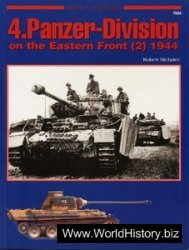It was the great shortage of trucks that suddenly made SS leader Heinrich Himmler’s units of importance to the army. After the Polish campaign the few SS regimental combat groups that had battle experience were reorganized. Three SS regiments—Deutschland, Germania, and Der Fiihrer—became the SS-Verfugungsdivision. The elite SS-Leibstandarte Adolf Hitler was reinforced far beyond regimental strength.
Himmler had served in the First World War without seeing combat. He had been accepted as an officer cadet, but by the time his training was completed, the war was over. He then tried to satisfy a yearning for military glory by joining veterans’ clubs, rifle clubs, and a semimilitary political organization called the Reichsflagge (National Flag). It was in this way that he came to join the Nazis.
By ruthlessly confiscating the property of Jews and using slave labor from concentration camps in the quarries and factories owned by the SS, Himmler grew more and more powerful. The entire German police service as well as the secret police (Gestapo) and security service (SD) were all at his command. Now the Second World War brought him a chance to be the military hero he had always wanted to be. Knowing these ambitions, the army watched Himmler and his SS with dislike and distrust, feelings that were not assuaged by reports the Army High Command were receiving about atrocities committed by SS-Einsatzgruppen in conquered Poland.
Himmler was determined, however, that the SS should become the nucleus of a postwar German national police service. And he believed that only if his SS men served in the front line would they earn sufficient public esteem to do their police work properly. Yet Himmler’s manpower was strictly limited, and only with the army’s consent could he legally recruit men of military age. Most SS men were part-timers, called into the army just as everyone else was.
The archetypal bureaucrat, Himmler exploited the law to suit himself. He was permitted to recruit for his police service and concentration camp guards in order to keep them at normal strength. Now, although few policemen were members of the SS, he drafted 15,000 of them into his field divisions to form SS-Polizeidivision. He then similarly drafted concentration camp guards to form the SS-Totenkopf-division.32 By exploiting this loophole, Himmler more or less doubled his field divisions, but the army could not prevent him calling reservists into—and recruiting for—his depleted services.
Himmler32 used other methods to swell his army. From his parttime Allgemeine (General) SS he called young men before they became eligible for military service. Since such recruits were in the SS before they were due to register for military service, the army had trouble finding out what was happening. From Poland and Slovakia he recruited Germans living there, in addition to any other “Germanic” foreigners who were not liable for military draft. By May 1940 there were five Americans, three Swedes, and forty-four Swiss volunteers serving with the SS.
Without asking anyone’s permission, Himmler had given his Watfen-SS men field-gray uniforms exactly like those worn by the army. The generals complained, but Himmler shrugged and said that it was too late to change. Though the army tried to obstruct him, Himmler still found ways to equip his force, much SS equipment at this time being of Czech origin. Hitler was persuaded to authorize a heavy artillery battalion for each of Himmler’s three formations and gave the Leibstandarte an extra battalion of light artillery. All of this artillery was motorized. (The Polizeidivision was the only SS unit not motorized; to speed things along, a regular army horse-drawn artillery regiment was temporarily attached it it.)
Suddenly Himmler’s Waffen-SS looked like a formidable fighting force. His men were at the peak of physical fitness; until 1936 one filled tooth had been enough for a man to fail a medical. The Leibstandarte only recruited men under twenty-three years of age and over six feet tall. The men were more strictly disciplined than any of the rest of the armed forces. Even so, the huge German Army could still afford to dismiss the comparatively tiny force that Himmler offered, except that most of it was motorized. Himmler’s field force could virtually double the motorized infantry that the German army had available at this time. Furthermore, it came complete with supply and support services, 10,000 men in the Ersatz (replacement) regiments, medical, legal, and administrative services, as well as officer training schools and training units.
The German Army had just increased its armored divisions from six to ten, with only four motorized divisions to follow them. For such an army, Himmler was offering a component that they simply could not refuse.




 World History
World History









